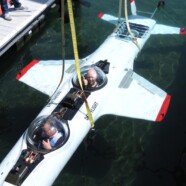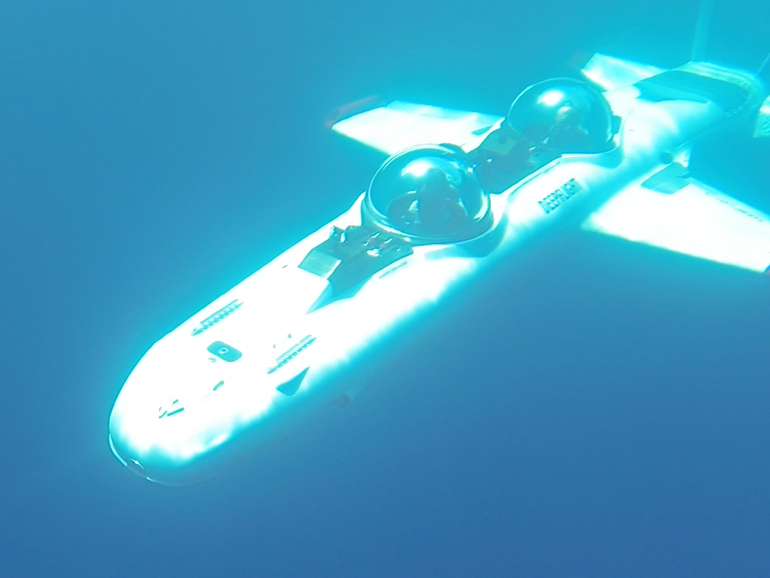Underwater Aviation
Underwater aviation, flying to the ‘edge of darkness’
by Daniel Terdiman / CNet
LAKE TAHOE, Calif. — “OK, Jschool, if you’re comfortable, we’ll go exploring.”
Strapped in with a five-point harness, and crammed into a space hardly bigger than me, I was comfortable, actually, and so off we went. Down, toward the edge of darkness.
It was a gorgeous Thursday earlier this month, and I was sitting in the rear seat in the DeepFlight SuperFalcon, a two-person submersible designed to “fly” the world’s oceans. In front was Graham Hawkes, a sixty-something bespectacled, besweatered Englishman with gray streaks in his dark hair. Hawkes is the SuperFalcon’s lead designer, and the founder of DeepFlight, one of the world’s foremost creators of submersibles. For the purposes of radio communications during our ride, deep into one of the most famous lakes on Earth, my nickname would be “Jschool.” Hawkes was “Grey Hawk.”
This was a ride to which I’d been looking forward for a long time. Six years, if we’re keeping score. In 2008, when adventurer Steve Fossett died in a plane crash in California’s Sierra Nevada mountains, his plans to be the first human to dive solo to the bottom of the 36,000-foot-deep Mariana Trench died with him. But the craft he was planning on diving in, the so-called DeepFlight Challenger, was still around.
Designed by what was then known as Hawkes Ocean Technologies, a Richmond, Calif., company, the submersible was the first of its kind. Reading about this machine, I was captivated, and soon wrote the first of many stories about Hawkes’ machines. But no matter how much I talked with the company about its technology, no matter how many pictures of it I saw, or even how close I got to it (at a launch event for the SuperFalcon in 2009), I knew something was missing: Actually getting to fly underwater.
But persistence pays off, and in early April, the email I’d been waiting for finally arrived — an offer to take a ride. DeepFlight would be testing a SuperFalcon in Lake Tahoe in a few weeks. Would I be interested? I was in Palau at the time, reporting on an entirely different kind of underwater science and technology, but there was only one possible answer: You’re darned right I’ll be there!
150 feet down
At 150 feet below the surface of Lake Tahoe, the world is very, very blue. There’s some light, but the surface, far above, isn’t really in the picture. If you’ve ever scuba dived, you know that 150 feet is beyond the realm of all but a very few, very advanced divers. But in the SuperFalcon, which keeps its occupants at more or less the pressure of the surface, 150 feet is just getting started. Still, Hawkes mentions, over the in-ear radio system that connects us, that we’ve just passed the point where most people will ever go, and “if you look ahead, you can see the edge of darkness.”
It’s a phrase he’s mentioned several times. And now, approaching it, I can see why: as the bottom drops away, heading down below us, everything gets inky black. We angle up instead, heading back towards the surface and an abundance of light.
While the DeepFlight Challenger was designed to safely take Fossett — and later, its new owner, Richard Branson — to 36,000 feet, the SuperFalcon is meant to top out (bottom out?) at around 400 feet. At $1.7 million, this is not something most people will ever be able to experience, and in fact, Hawkes is blunt that DeepFlight’s customers are “very rare individuals” who, for example, can launch the submersibles off their superyachts — a category of boat that Hawkes notes start at $17 million. Indeed, DeepFlight’s short list of customers reads like a who’s-who of world-famous explorers and adventurers: Virgin’s Branson, the late Fossett, infamous venture capitalist Tom Perkins, Red Bull founder Dietrich Mateschitz, and now an unnamed Russian oligarch.
Though DeepFlight offers its customers an extremely rare and utterly fulfilling experience, it has sold very few of its vehicles. “We’ve had to ask why we haven’t sold hundreds of these already,” Hawkes admitted, but he added that, for the superrich, something like a SuperFalcon may well be “an impulse purchase,” something that can’t be satisfied with DeepFlight’s standard 9-to-12 month build time.
Now the company is in the middle of designing the SuperFalcon Mark II, an advanced version that should make it even easier to fly, and to load people in and out. DeepFlight hopes to build up a small stockpile in order to be able to satisfy a few orders at once.
‘There are no passengers’
For most people, flying on an airplane means sitting back and letting the pilot do all the work while you eat terrible peanuts. On a SuperFalcon, “there are no passengers,” Hawkes tells me right up front. That means that each person has a full set of flight controls. That also means that while Hawkes did most of the flying during my ride, I was also the pilot for a bit.
Hawkes flew us down to a spot where he was confident I couldn’t do any harm — perhaps 50 feet or so below the surface, yet well above the bottom. Using a small black joystick positioned just to the right of my right leg, I pushed forward, and the SuperFalcon jerked downward. Then I pulled back, and it went the other way.
It reminded me of every time I’d tried a flight simulator, and ended up crashing my virtual plane. In fact, Hawkes had told me that flying the SuperFalcon had a lot in common with flying a plane, with the notable exception that if something goes really wrong in a plane, you crash and die. In a SuperFalcon, if the systems fail, as in a stall, the positively buoyant craft simply floats to the surface. He recalled giving a ride to a resort owner in a previous generation of the submersible and stalling, and how the vehicle had gently returned to the surface, broken through on its back, and then righted itself. Rather than being terrified, the resort owner said, “‘Can we do it again?'” “If we’d been [in a plane],” Hawkes said, “we’d have both been killed. Instead, it was ‘Can we do it again?'”
For me, it was simply a matter of understanding how sensitive the flight controls were. It was all about being gentle. Soon, I had the SuperFalcon moving gracefully through the water. Well, sort of gracefully. Hawkes laughed, and said, “You’re OK. An hour of this and you’ll be great.”
I’ve just joined an extremely exclusive club. As Hawkes put it, “Fewer people have flown underwater than have been in space.”
Flying with animals
Though being in the SuperFalcon has obviously been a longtime dream, the downside of riding in it in Lake Tahoe, as gorgeous as the surrounding mountains are, is that there is next to no marine life. Hawkes explained that we’d be going into a realm where 94 percent of the planet’s life is — but just not in this particular body of water. Indeed, though it is stunningly blue, and calm, and unlike anything I expected, it’s also kind of empty. The bottom, when we can see it, is just sand, with little more than the occasional sunken piece of wood to break things up.
But the SuperFalcon was designed with something altogether more glamorous in mind: “flying with big animals.”
That’s what Perkins wanted a SuperFalcon for, Hawkes explained. And Branson, too, was enthralled by the notion of plying the world’s oceans, huge marine beasts flying alongside. “I got the most excited email I ever got from [Perkins],” Hawkes said. “‘I’ve just flown with dolphins, it’s just amazing.’ That’s Tom Perkins saying that. Anybody else, OK, but if it’s Tom Perkins saying something’s amazing, you’d better believe it.”
Then there’s the expedition DeepFlight went on with GoPro in a whale sanctuary in Hawaii, searching for elusive humpback whales, and attempting to hear, and record, those beasts’ songs. A successful mission, it was memorialized in a stunning video. (watch video below, after this article)
For Hawkes, though, the highlight of his years of work developing submersibles and spending countless hours under the sea has been diving with great white sharks. With a sparkle in his eye, he recalled a particular ride in 2011, Branson sitting behind him (in the very seat I was in) as the two of them navigated into and through a pod of great whites.
“Every time we were in the water, we’d be tailed by [them], at our 6, right behind us,” Hawkes said. “We’d turn around, and we’d never see it.”
But they knew the sharks were there. They didn’t know how many sharks there were, but he guessed “a lot.” Finally, paydirt! They didn’t find the shark — it found them. “This big animal came in, it predicted our path, and just waited for us. It fell in formation. [Branson] yelled in the back, ‘Graham, look, to your left!'” And there it was — a giant great white, just off their wingtip.
Looking back, Hawkes thinks that the sharks believed that the SuperFalcon, long and thin, might have been an animal they had to chase off. “We do know a little bit about these animals,” Hawkes said of their territorial showdowns. “They typically go side by side, and it’s a dance, a standoff. They look at each other, and the smaller one is supposed to go, ‘OK, you’re bigger than me, I’m going.’ And peel off.
“We were two crazy Englishmen. We were just in awe. Richard was going, ‘Get closer, get closer!’ And I’m like, ‘Richard, I’m not going to lunge at a great white…But I did edge closer, and in the end, she backed off. She gave a big flick of her tail, and she was gone.”
Afterwards, he and Branson “were laughing. We were high as kites.”
I asked him what would have happened if the shark had attacked. Most likely, he said, the vehicle would have been fine. “But we’d have needed diapers, for sure.”
Even for Hawkes, someone who built a submersible for the 1981 James Bond film, “For Your Eyes Only,” who would likely have had the honor of building the record-breaking Mariana Trench vehicle if Fossett hadn’t died, who has spent hundreds of hours flying in the sea, this was the topper.
“For a human being to be that close to a big predator,” he began, “it’s just awe. Your mind just goes very quiet. I’m sure my jaw dropped, my eyes went wide. There she was. I was looking at her straight in her eye. What can I say? That was worth every bit of my life’s work, to be honest, just those few moments.”
Source: Daniel Terdiman / CNET
Note:
Daniel Terdiman is a senior writer at CNET News covering Twitter, Net culture, and everything in between.
==========================================
Renowned submersible designer Graham Hawkes and co-pilot Lee Behel go on a surreal adventure in the DeepFlight Super Falcon submersible. Using their hydrophones and their wits, our intrepid explorers cruise the underwater valleys of Hawaii in an attempt to capture a whale song. The DeepFlight Super Falcon submersible was designed, built and operated by Hawkes Ocean Technologies.
GoPro: DeepFlight Submersible – Searching for Whale Song




